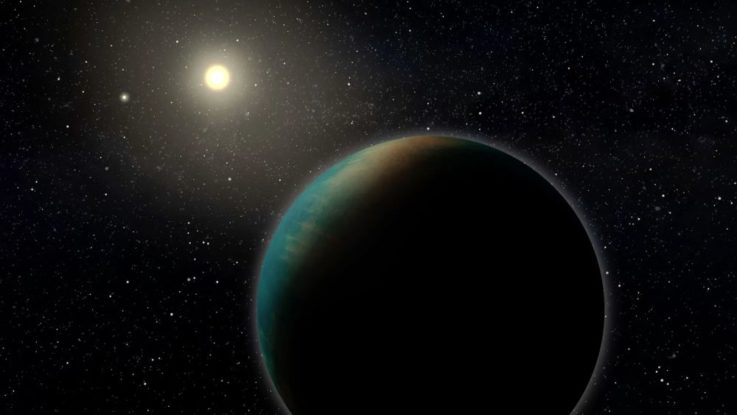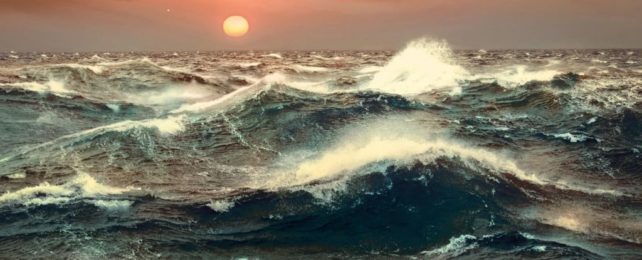An exoplanet just 100 light-years from Earth appears to be the best candidate yet for a sloshy, water-covered ocean world.
It's called TOI-1452b, and measurements of its size and mass suggest a density profile consistent with a global liquid ocean. Scientists believe that worlds like this are possible, but they haven't yet conclusively found one.
We'll need to follow up with observations from the James Webb Space Telescope to study the exoplanet's atmosphere and make a more confident ruling on the nature of TOI-1452b, but the initial results are very intriguing.
"This paper reports the discovery and characterization of the transiting temperate exoplanet TOI-1452b," writes a team of researchers led by astronomer Charles Cadieux of the University of Montreal in Canada in a paper published in The Astronomical Journal.
"The results of our interior modeling and the fact that the planet receives modest irradiation make TOI-1452b a good candidate water world."
It's easy to see why TOI-1452b evaded detection until now, in spite of its relative closeness to the Solar System.
The exoplanet was found orbiting one of a close binary pair of small, dim red dwarfs, separated by a distance of just 97 astronomical units. That's so close together that the two stars appear to be one.
However, the TESS exoplanet-hunting telescope is sensitive enough to have detected regular, faint dips in starlight that indicate an object regularly passing between us and its host star; those passages across the star are known as transits. The researchers followed up with their own highly sensitive instrument also designed to detect exoplanet transits at Mont Mégantic Observatory in Canada.
The observations from both telescopes revealed that there is indeed an exoplanet orbiting one of the stars in the TOI-1452 binary.
By looking at how much light the star emits and how much it dims when the exoplanet passes in front, the researchers were able to ascertain that the exoplanet is relatively small, coming in at 1.672 times the size of Earth – what we call a super-Earth.
It's on an 11-day orbit with its star, which seems insanely close to us, with our comparatively leisurely 365-day orbit. However, because the star is so cool and dim compared to the Sun, this places the exoplanet bang in the middle of the star's temperate zone. This is not so far from the star, out in the cold, that any liquid water on its surface would freeze, nor so close that the water would evaporate under the star's heat.

Next, the researchers took a closer look at the star. Specifically, they studied its radial velocity – the way it moves about due to the gravitational influence of the exoplanet. That's because any two bodies in a system orbit a mutual center of gravity – meaning that the star moves about, just a little, in its orbital arrangement with TOI-1452b.
Changes in the star's light reveal this motion and, even better, allow astronomers to calculate the orbiting body's mass by determining the strength of that movement. So, they were able to derive a mass of 4.82 times that of Earth for TOI-1452b.
And this is where it starts to get really interesting.
Once you have the size and mass of an object, you can infer its average density. For TOI-1452b, that density is 5.6 grams per cubic centimeter, and that's very close to Earth's density of 5.5 grams per cubic centimeter. But a density similar to that of Earth, for an object that has more mass, indicates that the object is composed of a lighter material, the researchers said.
"TOI-1452b is one of the best candidates for an ocean planet that we have found to date," Cadieux says. "Its radius and mass suggest a much lower density than what one would expect for a planet that is basically made up of metal and rock, like Earth."
They modeled the exoplanet's interior composition and determined that as much as 30 percent of its mass could be water.
That's a huge amount of the wet stuff. For comparison, water makes up less than 1 percent of Earth's mass; TOI-1452b's composition seems closer to that of water moons Europa in orbit with Jupiter and Enceladus in orbit with Saturn.
However, with just the measurements we have, it is impossible to say exactly what TOI-1452b is made of. This is where Webb comes in.
You remember how the exoplanet passes between us and its star? Some of the star's light will pass through the exoplanet's atmosphere, if it has one. Webb is sensitive enough to detect the difference in that light in enough detail that scientists can work out what's in the exoplanet's atmosphere.
If TOI-1452b is a water world, Webb is our best shot at discovering it.
"Our observations with the Webb Telescope will be essential to better understanding TOI-1452b," says astronomer René Doyon of the University of Montreal. "As soon as we can, we will book time on Webb to observe this strange and wonderful world."
The research has been published in The Astronomical Journal.
